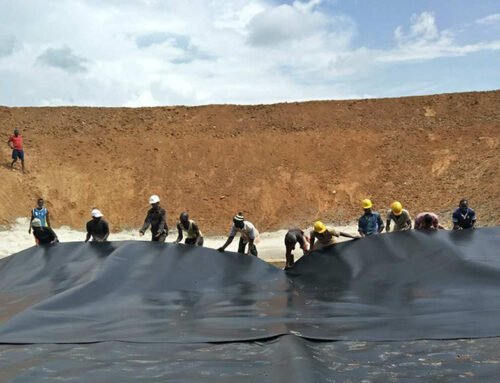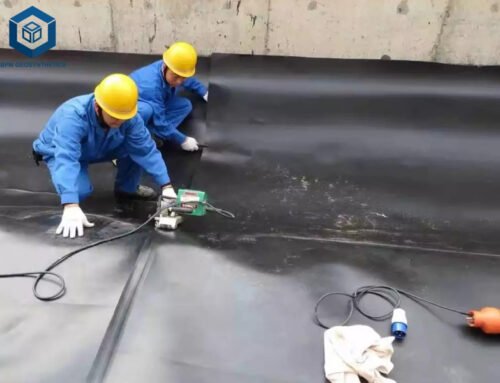BPM newly developed and engineered HDPE textured geomembrane has been successfully put into production in February, 2019. Our specially designed HDPE textured geomemrbane liner production line and manufacturing process is the ideal geotechnical product for landfill and waste containment applications.
BPM has always been responsible for develop best HDPE geomembrane products and best services for your requirements. In order to improve the supply capacity and satisfy project requirements of landfill and mining applications, etc, BPM has developed a new HDPE textured geomembrane production technology.
1.What Is HDPE Textured Geomembrane?
HDPE textured geomembrane is a type of geomembrane that is manufactured using high-density polyethylene (HDPE) material and has a surface with raised studs or embossed patterns. These patterns are designed to provide additional friction and improve the liner’s performance in terms of stability, slope protection, and resistance to slippage.
During the manufacturing process of HDPE textured geomembrane, a pattern of raised features is created on the surface. These features can vary in shape, size, and pattern, depending on the specific manufacturing technique used and the intended application of the geomembrane.
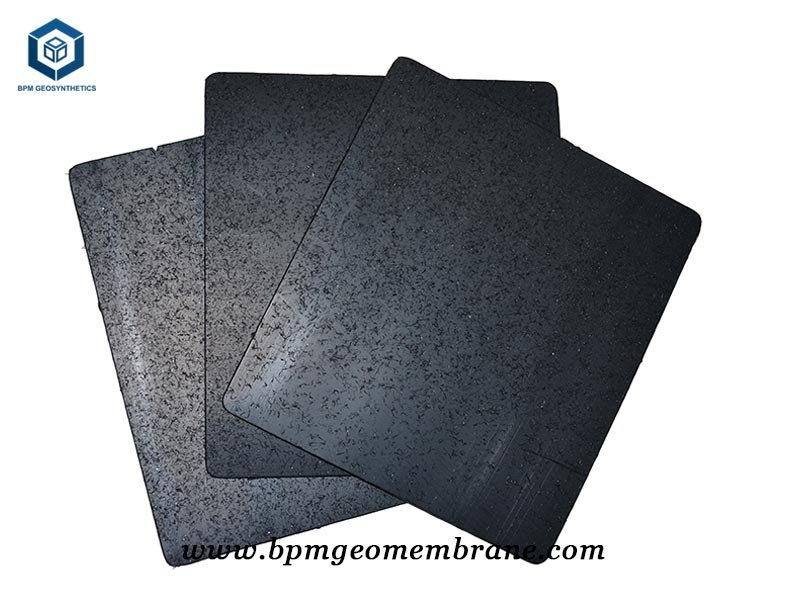
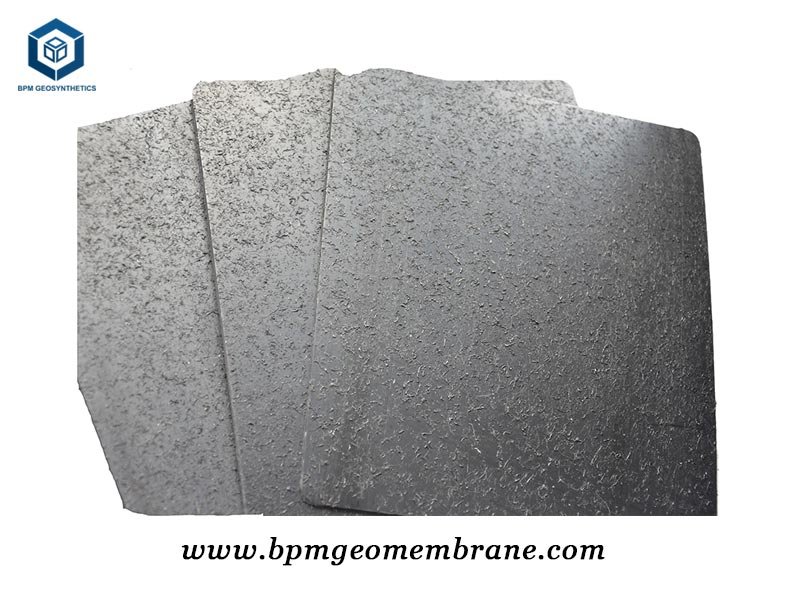
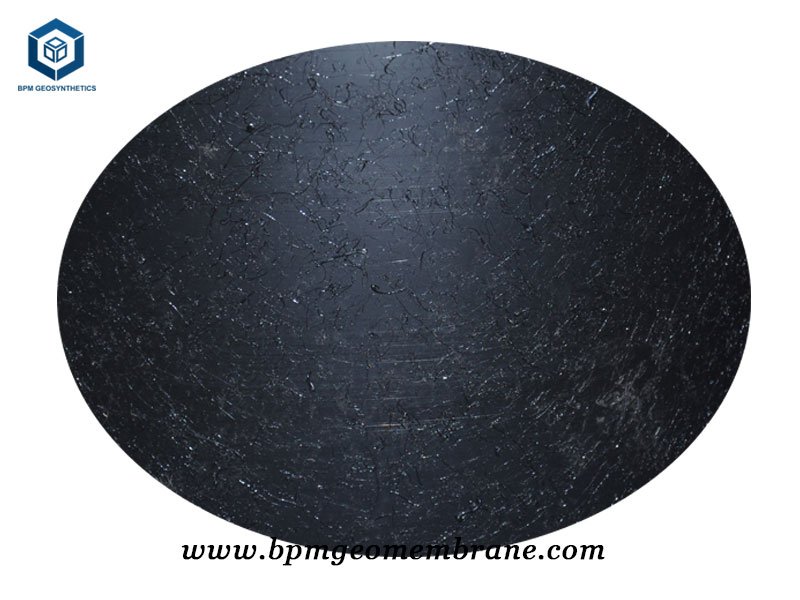
2.What Are Characteristics of HDPE Textured Geomembrane?
HDPE textured geomembranes possess several key characteristics that make them suitable for various applications. Here are some common characteristics of HDPE textured geomembranes:
2.1 Frictional Properties
Textured HDPE geomembranes significantly improve slope stability through enhanced surface friction. The embossed patterns or studs create mechanical interlock with adjacent soils and geosynthetics. This frictional resistance prevents liner slippage even on steep inclines up to 45 degrees. Engineers frequently specify textured liners for landfill caps, pond berms, and other sloped applications. The surface treatment maintains performance while eliminating the need for additional anchoring systems.
2.2 Shear Resistance
The textured surface of geomembranes significantly boosts shear strength between the liner and adjacent materials. This enhanced friction prevents soil movement along slopes, maintaining system integrity. Engineers particularly value this feature for steep applications like landfill sidewalls or reservoir embankments. The surface patterning creates reliable grip without compromising impermeability. Such performance makes textured liners ideal for critical containment projects requiring long-term stability.
2.3 Surface Protection
The textured surface of geomembranes provides enhanced protection against environmental stressors. Raised studs create a buffer zone that minimizes direct UV exposure to the base material. This surface pattern also distributes abrasive forces across multiple contact points, reducing localized wear. Sharp objects encounter resistance from the textured profile before reaching the membrane’s core. These combined effects significantly extend the liner’s service life in demanding applications.
2.4 Flexibility
Textured HDPE geomembranes adapt easily to uneven terrain due to their inherent flexibility. The material conforms smoothly to irregular contours during installation without cracking or tearing. This pliability accommodates minor ground movements and settling over time. Installers appreciate how the textured surface maintains grip while adjusting to subgrade variations. Such versatility makes these liners ideal for projects with complex topography or unstable soils.
2.5 Chemical Resistance
HDPE geomembranes demonstrate exceptional chemical resistance across acidic, alkaline, and solvent exposures. Their molecular structure remains stable when contacting harsh substances in landfills or industrial sites. Textured variants maintain this durability while adding frictional benefits for sloped applications. Engineers rely on this dual performance for containment systems handling aggressive leachates or wastewater. The material’s inert nature ensures long-term integrity despite continuous chemical contact.
2.6 UV Resistance
HDPE textured geomembranes incorporate UV stabilizers that effectively resist solar degradation. These additives protect the polymer chains from breaking down under prolonged sunlight exposure. Outdoor installations benefit particularly from this feature, as it maintains material integrity for decades. Landfill caps and exposed pond liners demonstrate the technology’s real-world durability. The textured surface further enhances UV resistance by diffusing light exposure across its patterned profile.
2.7 Customizability
Manufacturers tailor HDPE textured geomembranes to address unique project specifications. Engineers select from various stud patterns – including pyramidal, dimpled, or custom configurations – to optimize friction for specific slopes. Production lines adjust thickness (0.5mm-3.0mm) and width (2m-8m) to balance durability with installation requirements. This customization capacity enables precise solutions for landfill caps, mining operations, or water containment systems. Project teams collaborate closely with manufacturers to develop geomembranes that address both technical and budgetary constraints.
3.How Is HDPE Textured Geomembrane Produced?
HDPE textured geomembranes are typically produced through a manufacturing process that involves several steps. Here is a general overview of how HDPE textured geomembranes are produced:
3.1 Material Preparation
Manufacturers begin by selecting premium-grade HDPE resin as the base material for geomembranes. They melt the resin pellets in controlled-temperature extruders while blending in critical additives. Antioxidants integrate into the polymer matrix to prevent oxidative degradation over time. UV stabilizers distribute evenly throughout the molten material to ensure consistent sunlight resistance. Processing aids facilitate smooth manufacturing while maintaining the geomembrane’s mechanical strength.
3.2 Extrusion
Operators feed the blended HDPE material into a high-capacity extruder for melting and shaping. The machine applies precise heat and pressure to transform the resin into a homogeneous molten state. A specially designed flat die then forms the material into a continuous, uniform sheet. Temperature controls maintain optimal viscosity throughout this forming process. The emerging sheet moves directly into the next production phase while maintaining consistent thickness and width.
3.3 Texturing
The extrusion line incorporates patterned embossing rolls to create the textured surface. These precision-engineered rolls press into the hot HDPE sheet immediately after it exits the die. The still-molten polymer perfectly retains the inverse pattern from the rolls’ surface. Different roll designs produce varying texture profiles – from standard studs to custom configurations. This in-line embossing method ensures consistent pattern depth across the entire sheet width.
3.4 Cooling and Sizing
After the texturing process, the textured HDPE sheet is rapidly cooled to solidify it. Cooling can be achieved through contact with cooled rollers or immersion in a water bath. Once cooled, the sheet is trimmed to the desired width and cut into rolls of appropriate length.
3.5 Quality Control
Throughout the production process, rigorous quality control measures are implemented to ensure dimensional accuracy, uniform thickness, and overall product quality. Parameters such as temperature, pressure, and dimensions are continuously monitored. Additionally, off-line testing is conducted to assess mechanical properties and other performance characteristics.
3.6 Packaging and Storage
The finished HDPE textured geomembrane rolls are carefully packaged and labeled for transportation. They are stored in a controlled environment to shield them from UV exposure, moisture, and potential damage before reaching end-users or distributors.
4.What Are Textured HDPE Geomembranes Used for?
Textured HDPE geomembranes have a wide range of applications. They are used for environmental containment, pond and reservoir lining, mining and heap leach pads, agriculture and aquaculture, secondary containment, civil engineering and construction, as well as waterproofing and roofing. These geomembranes provide enhanced frictional properties, stability, and protection against seepage, erosion, and chemical corrosion.
In environmental applications, they are used to line landfills and waste storage facilities. They are also employed for pond and reservoir lining in water storage structures. In addition, they find use in mining and agriculture for containment and erosion control. In construction, they are used for slope stabilization and canal lining. Lastly, they serve as effective barriers in secondary containment and waterproofing projects.
5.About BPM
BPM is the professional geosynthetics manufacturer and wholesaler. Our main innovative, high quality geosynthetic products include geomembranes, geotextiles, geocells, geosynthetic clay liners (GCLs), drainage boards, geogrids, etc. BPM brand geosynthetic product had been certificated by the ISO9001, ISO14001,OHSAS18001 Soncap, SASO and BV certificates and passed the test of SGS and Intertek, etc. Our geosynthetic products have exported to over 100 countries.
If you have any questions or inquiries, please contact us, we will reply as soon as possible.



